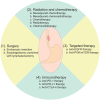Understanding Esophageal Cancer: The Challenges and Opportunities for the Next Decade
- PMID: 33014854
- PMCID: PMC7511760
- DOI: 10.3389/fonc.2020.01727
Understanding Esophageal Cancer: The Challenges and Opportunities for the Next Decade
Abstract
Esophageal cancer (EC) is the seventh most common cancer worldwide with over 570,000 new cases annually. In China, the incidence of EC is particularly high where approximately 90% of cases are defined as esophageal squamous cell carcinoma (ESCC). Although various risk factors have been identified, the knowledge of genetic drivers for ESCC is still limited due to high mutational loading of the cancer and lack of appropriate EC models, resulting in inadequate treatment choices for EC patients. Currently, surgery, chemotherapy, radiation, and limited targeted therapy options can only bring dismal survival advantages; thus, the prognosis for ESCC is very poor. However, cancer immunotherapy has unleashed a new era of cancer treatment with extraordinary therapeutic benefits for cancer patients, including EC patients. This review discusses the latest understanding of the risk factors and clinical rational for EC treatment and provides accumulated information, which describes the ongoing development of immunotherapy for EC with a specific emphasis on ESCC, the most prevalent EC subtype in the Chinese population.
Keywords: clinical management; epidemiology; esophageal cancer; genetics; immunotherapy; risk factors.
Copyright © 2020 Yang, Liu, Cao, Dong, Rao and Cai.
Figures
References
Publication types
LinkOut - more resources
Full Text Sources



